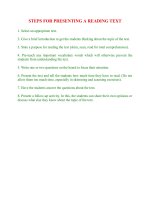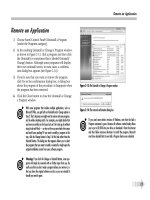litle steps for new parents
Bạn đang xem bản rút gọn của tài liệu. Xem và tải ngay bản đầy đủ của tài liệu tại đây (7.86 MB, 129 trang )
Little Steps
for
New Parents
What people are saying about
Little Steps for New Parents:
What a terrific book! The idea of giving parents bits of useful information on a weekly
basis is simply brilliant. And I loved the layout—especially all those pictures of dads
and babies.
Wade F. Horn, Ph.D. President, The National Fatherhood Initiative
As a grandmother of six, I have found your book a tremendous help for each of my four
daughters and their first encounter with their newborns. The easy way it is laid out
meant they didn’t have to look through pages of information. Keeping the journal was
fun too.
Barbara Eldridge, President Mindmasters
The simplicity, quality of information, and opportunity to actively enjoy being a family
right from the beginning make this journal something to use and then treasure for a
lifetime.
Carol Kuna, M.A. Early Childhood Specialist
As more is learned regarding the importance of infant brain development and
stimulation, parents will become increasingly eager for suggestions on how to provide
a suitable environment for their infant. Little Steps for New Parents is a great tool.
Parent Educator and Program Specialist, FL.
From a special group of young mothers in Long Beach, CA:
I love writing about my baby. This is a whole year’s worth of treasured memories.
This book helps me understand more about my baby and the different things I can do.
This book gives me encouragement to do my best as a mother and tells me things to do
for myself and my baby and I feel more confident.
This book explains how much love and attention my baby needs and it really helps me
to learn how to communicate with my baby.
I learned that it is important to make my baby feel comfortable, loved, safe, and secure.
When he grows up I will show him the book.
Little Steps
for
New Parents
Birth to One Year
A Weekly Guide for Developing
Your Baby’s Intelligence
Sandy Briggs
PERSONHOOD PRESS
!!!Books for ALL that you are!!!
Little Steps for New Parents: Birth to One Year
A Weekly Guide for Developing Your Baby’s Intelligence
by Sandy Briggs
Consultants: Carol Kuna Lapetito, M.A. Early Childhood Special Education
Nancy B. Carlson, Ph.D., CCC/SLP Speech Pathologist
Susan Bañuelos Smith, R.D.
Editor: Gail M. Kearns
Book Production: Penelope C. Paine
Layout & Typography: Christine Nolt, Cirrus Design
Cover Design: Robert Howard
Copyright © 2003 by Sandy Briggs
Original edition copyright © 2001 Briggs & Company and published by Briggs & Company
(800) 662-9662
E-mail:
Web Site:
All rights reserved. No part of this book may be reproduced or transmitted in any form or by any means
without permission in writing from Personhood Press. Reproduction of any part of this book,
through photocopy, recording, or any electronic or mechanical retrieval system, without the
written permission of the publisher, is an infringement of copyright law.
Every effort has been made to present the most accurate and accepted developmental practices.
However, each baby has different needs, and this information may not be appropriate in every case. We
urge that you check with your physician, midwife, or other related health professionals before
undertaking or choosing not to undertake any course of action, and we recommend that you always
follow the advice and recommendations of your health practitioner. Sandy Briggs is not a medical
professional, nor is she engaged in rendering medical advice. She takes no responsibility for any
consequence relating directly or indirectly to any information, recommendation, treatment, procedure,
action or application of medicine by any person using this book.
Library of Congress Catalog Card
ISBN L-932181-04-0
Contents
Introduction 9
A Special Message 11
How to Use This Book 12
First Things First—Bringing Baby Home 14
Weeks 1 through 52 16
Creating a Learning Environment in the Upcoming Years 120
Everyone Needs a Little Help Sometimes! 123
Photographs, Keepsakes and Comments 124
About the Author 126
Order Form 127
8
You are your baby’s first and most important teacher.
And, yes, you are qualified for this critical position.
There is no such thing as a perfect parent—you simply
do your best. For healthy development, your baby
needs to be loved, talked to, held, and allowed to
explore. It’s likely that not having enough time will be
your biggest challenge. Make being with your baby
your first priority.
L
i
t
t
l
e
S
t
e
p
s
9
Introduction
S
cientists now know that the very first years of life are critically important for healthy brain
development. The environment you provide, especially in the first three years, has a
profound effect on that development and your baby’s future.
Because of this, Little Steps is somewhat different than other books you may have read on
child development. The main focus is the development of your child’s brain.
The many simple and enjoyable activities included here will help your baby’s development in
the early years. We also give you information to help you better understand how your child is
developing. This understanding will help guide you in the upcoming years.
A loving and interesting environment will have a positive impact on your baby’s future.
Neglect and or being exposed to constant anger or stress will have a negative impact on your
child’s future.
Much of the foundation for your baby’s future is being built in the first three years of life.
These three years will, to a large degree, determine how well a child will:
● Learn
● Solve problems
● Express and control emotions
● Get along with others
● Form their attitude toward life
Fortunately, babies are very motivated to learn. They are curious and want to touch
everything. They look for the chance to build their skills (and their brain). They will repeat and
build upon a skill until they are ready to move on to the next step.
The good news is that the more enjoyable you make this time for you and your baby, the
better the chance your child has of becoming a confident and competent adult.
Playing is one of the best ways for you to help your child develop. Simple play like trying to
hold or grab a rattle is important brainwork for your baby. So is seeing you smile. Even touching
your face is a learning experience.
Knowing that you are there when she needs you is one of the most important things you can
do for your baby. She quickly learns that she’s safe to explore and learn when you are there just
in case she needs help. This helps her build confidence.
There’s no reason to pressure your baby into learning something that she’s not ready for or
doesn’t want to do—at least not at this age. We all learn best when we’re having fun, enjoying
ourselves, and when something is interesting.
It’s a challenge for you to provide interesting activities and yet not pressure your baby to
move at too fast a pace for her. Don’t worry—you’ll do just fine. Your baby will give you lots of
clues. You’ll find that you quickly become creative and patient.
Your baby is an individual with her own special talents and personality. Treasure these and
help her develop into the very unique person that she is. This does not take expensive toys. It
does take love, time, patience, and lots of hugs.
10
L
i
t
t
l
e
S
t
e
p
s
WE CONTINUE TO LEARN ALL
THROUGH LIFE, BUT IT SEEMS
THAT THE EARLY YEARS SET
THE STAGE.
L
i
t
t
l
e
S
t
e
p
s
11
A Special Message
O
ne of the most frustrating challenges for a parent or a caregiver is how to deal with a crying
baby. Sometimes a baby’s needs are obvious and quickly taken care of. Sometimes you
simply have no idea how to help.
Some of the most common reasons for crying are hunger, discomfort, or just being tired.
Sometimes your baby really needs to be picked up and held, and sometimes he just wants to
fuss. If your baby seems to be in pain, call a doctor.
Infants and young children need to be held and touched. Their brains need input and
stimulation to develop, and they are eager to gain new information. By crying, they get this
needed attention and food for their brains.
If feeding and changing your baby doesn’t work, try waiting for a few minutes. Pat him on
the back and quietly talk or sing. Place his thumb in his mouth. (Babies comfort themselves by
sucking their thumb or a pacifier.) Hold him to your chest and walk around, and hold his feet so
that he feels secure. Go for a walk in the stroller. Go for a ride in the car. Rocking chairs often
work and are comforting for both you and your baby. Turning on the vacuum cleaner seems to
quiet some babies.
Research shows that the best thing to do is to pick up your baby when he cries. In the first
year, he will not become spoiled. In the long run, he’ll learn faster how to calm himself—he
doesn’t know how to do this yet. Babies that are picked up soon after they start to cry seem to
cry for shorter periods of time.
Babies cry often in the first two to three months of life and then this gradually declines.
Some do cry more (and longer) than others. Many still believe that you should just “let them cry
it out.” Even as tired as you are, it is best to pick up your baby.
In later months, babies can become frustrated and get fussy when a new skill (or toy) is just
out of reach. If this is the case, step back and wait a few minutes. Let your baby try for a while
before you help.
Sometimes there is nothing you can do. Your baby is not crying to upset you. Many parents
feel helpless, and some begin to feel angry. Some anger is normal, but if your anger begins to
get out of control, put your baby in a safe place and leave the room until you cool off. It’s far
better for your baby to continue to cry than for you to get physically violent.
NEVER SHAKE YOUR BABY. Brain injury,
blindness, or even death can occur.
Never leave your baby with
anyone who cannot control
his or her anger.
How to Use This Book
E
ach week spend a few minutes reading the activity and notes. Write your own notes in
the space provided. Writing down what you and your baby are doing will help you
understand your baby. And you’ll enjoy reading and sharing this journal in later years.
Review past weeks often, and continue to use the activities as long as your baby enjoys
them. Babies love repetition. It’s one of the ways they build their brains.
Dads too will find that these activities are a great way to become close to his baby
right away.
For parents who have infants with special needs, talk with your health professionals
and Early Intervention Specialist to guide you in the best ways to get the most out of
these activities.
Your baby will develop at his own pace. Don’t be disappointed if he’s not ready for an
activity we have suggested. Not all activities will appeal to your baby. Follow his lead—he
knows what he likes and when he is ready!
12
L
i
t
t
l
e
S
t
e
p
s
In the first years as genes and experiences blend
to form a unique personality, the foundation
for the future is being laid.
L
i
t
t
l
e
S
t
e
p
s
13
Baby’s Name
Date of Birth
Time of Birth
Hospital
City State
Notes
First Things First—Bringing
Baby Home
E
very new parent feels a bit overwhelmed when they first come home with their tiny, fragile
little bundle. Even people who have spent a lot of time with infants are somewhat anxious
when they first bring their own baby home. The important thing right now is to make your baby
feel comfortable, loved, safe, and secure.
Pick up your baby when she cries, and try to find out what she needs. It may be hugging and
cuddling. Picking up a newborn each time she cries will not spoil her. It’s important for her to
learn that you will take care of her needs and that she is safe. When she is picked up often at an
early age, it’s more likely that she will begin to learn how to calm and quiet herself at an earlier
age.
Feed your baby when she’s hungry. At first, she may want to eat every one to two hours.
Talk and smile. Your baby can see your face, smell you, feel your skin, hear you, and can
even sense how you feel.
Health and Safety
Put your baby on her back when she sleeps. Make sure she’s on a firm surface with no
pillows or stuffed animals. Your baby needs to be able to easily move her head to breathe.
Keep your baby away from cigarette smoke. It’s very harmful to growing lungs.
14
L
i
t
t
l
e
S
t
e
p
s
Breast milk is the best food for your baby.
Breastfeeding is new for both
of you, and many moms need
a little help. Don’t hesitate
to ask for it!
Never shake your baby. This can easily cause brain damage and even death.
Choose babysitters very carefully. Don’t choose people who are easily upset or violent. Find
someone who has lots of time to cuddle your baby.
Loving care helps your baby’s physical and mental growth. Neglecting your baby is both a
physical and mental health risk.
Always read the information you receive from your health professional about your baby’s
health and well being. Ask questions even if you think they may sound silly. It’s important for
you to understand your baby’s needs.
You need to be healthy too. Eat nutritious foods and drink plenty of fluids. Take only the
drugs prescribed for you by your doctor. Rest or take a nap when your baby is sleeping.
L
i
t
t
l
e
S
t
e
p
s
15
Always put your baby in the car seat when riding in a car. Car seats
save lives but most are not used or installed properly, or don’t fit
the car. Learn how to protect your baby.
Week 1
A
s you begin this exciting journey filled
with loving, laughing, and crying, you
are probably experiencing many emotions
and have many concerns. Don’t worry.
Mother Nature did a good job in preparing
mothers, fathers, and even babies for this
adventure. You may have doubts about this
now, but you will gain confidence.
Getting to know each other can take a little time. When your baby is awake, cuddle and talk
to him. He needs lots of love.
It’s likely that your baby is going to want to eat about every two hours—both day and night,
for awhile. Feed him when he’s hungry. In between feedings, lay down and relax.
If your baby cries, pick him up and feed him, change him, or try to calm him. Picking up
your baby when he cries will not spoil him. Let your baby establish his own feeding schedule.
16
L
i
t
t
l
e
S
t
e
p
s
Health
Baby: Be careful. Babies’ heads and necks are
fragile. Always support the back of his neck
and his head when you pick him up.
Mom: Many new mothers have “the baby
blues” right after birth. Disappointment,
sadness, crying, feeling tired, and worrying
about being able to handle all of this is
pretty normal. Overwhelmed is a word that
often describes new moms.
Feeding
After your baby is several days old, make
sure he wets six or more diapers a day. This
will let you know if he’s is eating enough.
Don’t let him sleep more than five hours at a
time before feeding. If he falls asleep and
you don’t think he’s eaten enough, gently
wake him.
Keep a list of questions
to ask your doctor.
Don’t forget YOUR
health, too.
L
i
t
t
l
e
S
t
e
p
s
17
My Thoughts . . . Date
Your baby is already beginning to learn about his world. When
he’s awake and alert, he’s learning about this big, new world. He’ll
enjoy gazing into your eyes. Your smile and talking are already
stimulating brain growth.
Week 2
B
aby talk is a natural way for parents to talk to their
baby. Don’t worry about sounding silly. Your baby
will enjoy it, and it provides just the type of sounds
she needs. You’ll notice that most people will talk baby
talk to your baby.
Your baby’s eyesight will take awhile to develop. Right now, your baby can see things that
are about 8 to 10 inches away (about the distance from her face to yours when you are feeding
her). Things that are farther away are fuzzy.
Put your face close to your baby’s face and smile and talk to her. You can start by saying
anything. See how she watches and listens to you. Babies love to look at faces and listen to
voices.
Tell her that you’re going to pick her up and feed her. Tell her all the things you are
seeing as you take a walk. Tell her how wonderful she is and how much you love her. Sing to
your baby. She really likes to hear the sound of your voice and won’t mind if you’re not a
good singer.
18
L
i
t
t
l
e
S
t
e
p
s
Health
It’s time for the doctor to see your baby
for a two-week checkup. Bring a list of any
questions you have.
Carry your baby as much as possible
rather than put her in a stroller. She’s
getting a lot more “brain stimulation”
when she’s being held.
L
i
t
t
l
e
S
t
e
p
s
19
My Thoughts . . . Date
Did you know that your baby is already learning how to talk?
Every time you talk to her, her brain stores sounds that will
one day be words. She learns to talk by listening to you and
other important caretakers in her life.
Week 3
C
uddle and hold your baby often. This is good for his
development in many different ways. It’s especially
important in the first years.
One way to have your baby close to you is with an infant
carrier that holds him securely on your chest. Your baby can
hear your heartbeat and feel your warmth. Plus, he will be
close enough to see your face and hear you talk.
Dads are often concerned about how to pick up and hold
this tiny baby. But it’s important for your baby’s healthy
development for Dad to be involved. The sooner, the better.
(Grandpas, uncles, and caring friends are good, too.)
Have Dad sit in a comfortable chair. Gently place the baby in his arms so that the baby’s
head and neck are well supported. Show Dad how to put his face close and talk to him.
20
L
i
t
t
l
e
S
t
e
p
s
Health
Keep your baby away from cigarette
smoke. Secondhand smoke is not good for
adults, and is especially harmful for little
babies.
Learning how to talk is an amazing mental
accomplishment. Much of the foundation for this
learning is built before age one.
Health
Diarrhea can be a very serious problem
for babies if not treated. Continue to feed
your baby. If he won’t take food, or if the
diarrhea lasts more than 8 hours, call your
doctor. Call the doctor immediately if your
baby has blood in his diaper.
L
i
t
t
l
e
S
t
e
p
s
21
My Thoughts . . . Date
Your baby’s brain is getting information from
everything that he hears, sees, smells, touches,
and tastes. Even though he’s only awake for short
periods of time, there’s a lot of brain building
going on. He gets the kind of information
his brain needs when you hold him
and talk to him.
Week 4
Y
ou’ll be amazed by how much your baby will grow this year. Using washable finger paints,
make a handprint and a footprint on the next page (or use one of the blank pages in the
back of the book). Do this several times during the year.
Bath time is a good time for you and your baby to grow closer. She will begin to associate
you with comfort and pleasure. It will probably be a little awkward at first, for both of you. It
can be difficult to support your baby’s head and neck and still bathe her.
Playing in the bath is a perfect place to learn many new things. Right now, simple things like
splashing, feeling the warm water, and just being with you reinforces connections between brain
cells!
Many babies enjoy a gentle massage after a bath. Make sure your baby is kept warm. Many
oils and powders are not good for your baby’s skin. Ask your doctor before using them. Talk or
sing as both of you learn to enjoy this special time together.
22
L
i
t
t
l
e
S
t
e
p
s
Health
Make sure the room is warm enough for
baths. Put your elbow in the water. It should
be warm but not actually hot. Don’t poke
anything in your baby’s ears, and take care
to keep soap out of her eyes and mouth.
Don’t add bubble bath to the water.
Never leave your baby
unattended in or near
water, even if it’s very
shallow. Not even for
one minute!
L
i
t
t
l
e
S
t
e
p
s
23
My Thoughts . . . Date
Caring, loving, and playing is important for your baby’s brain
development. Constantly ignoring her cries or regularly showing
anger, stress, and tension can affect your baby’s brain
development in a negative way.
Week 5
W
hen your baby is lying in his crib, hold a brightly colored object about 8 to 10 inches above
his head. A rattle that makes a little noise will help get his attention. Slowly move the
object back and forth as your baby watches it. This is called eye tracking. Stop when he’s tired
or not interested.
Your baby can focus his eyes on close objects for about one minute. Bold and bright colors
are easiest to see. He can’t see pastel and light colors very well yet.
You can attach a piece of poster board or other heavy paper to the side of your baby’s crib
that’s against the wall. Paint simple, large, bold-colored patterns on it. A baby likes circles and
curved lines better than straight ones. Change these often—babies get bored, too.
As your baby’s eyesight gets stronger, move the crib around for different views.
24
L
i
t
t
l
e
S
t
e
p
s
Health
Don’t give your baby cow’s milk, water,
juice, or any adult liquids. Solid foods and
liquids usually begin at about 4 months of
age (see Week 17). Until then, your baby is
getting plenty of nourishment from breast
milk or formula. Follow your doctor’s advice.
Never leave your baby in a car
unattended by an adult
even if he’s asleep. Always
use a car seat.









